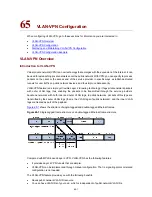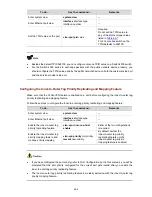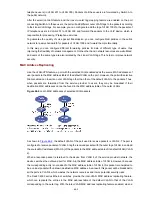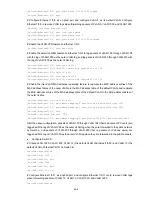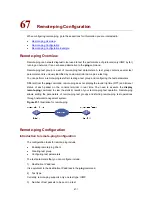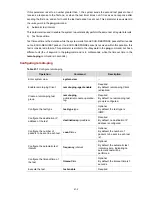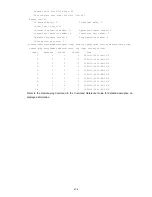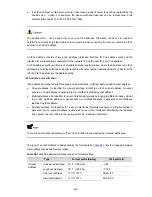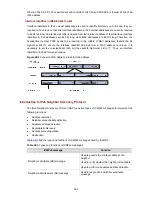
66-4
Do not enable both the selective QinQ function and the DHCP snooping function on a switch. Otherwise,
the DHCP snooping function may operate improperly.
Enabling the Inter-VLAN MAC Address Replicating Feature
Follow these steps to enable the inter-VLAN MAC address replicating feature:
To do...
Use the command...
Remarks
Enter system view
system-view
—
Enable the inter-VLAN MAC
address replicating feature
mac-address-mapping index
source-vlan source-vlan-id-list
destination-vlan dest-vlan-id
Required
By default, the inter-VLAN MAC
address replicating feature is
disabled.
z
On a port, the inter-VLAN MAC address replicating feature can be configured only once for a
destination VLAN. If the configuration needs to be modified, you need to remove the existing
configuration first.
z
With the inter-VLAN MAC address replicating feature disabled, all the MAC address entries that the
destination VLAN learns from the other VLANs through this function are removed.
z
MAC address entries obtained through the inter-VLAN MAC address replicating feature cannot be
removed manually. To remove a MAC address entry of this kind, you need to disable the
inter-VLAN MAC address replicating feature first.
z
VLAN 4093 is a special VLAN reserved for the XRN fabric feature. It can not serve as the
destination VLAN of the inter-VLAN MAC address replicating feature to receive MAC address
entries from the other VLANs.
Selective QinQ Configuration Example
Processing Private Network Packets by Their Types
Network requirements
z
Ethernet 1/0/3 of Switch A provides public network access for PC users and IP phone users. PC
users belong to VLAN 100 through VLAN 108, and IP phone users belong to VLAN 200 through
VLAN 230. Ethernet 1/0/5 of Switch A is connected to the public network. The peer end of Switch A
is Switch B.
z
Ethernet 1/0/11 of Switch B is connected to the public network. Ethernet 1/0/12 and Ethernet1/0/13
of Switch B provide network access for PC servers belonging to VLAN 100 through VLAN 108 and
voice gateways (for IP phone users) belonging to VLAN 200 through VLAN 230 respectively.





